
By David Schwager for CoinWeek …..
“We Buy Rare Plastic”
I haven’t seen this sign outside of a coin shop yet, but the right holder can be worth more than the coin inside. Many collectors know that the small certification slabs used in the first few years of PCGS (known as “rattlers” because they sometimes held their coins loosely, allowing the coins to rattle inside their encapsulations) earn premiums when they sell. Slab enthusiasts seek other, less-well-known scarce holders, such as the 10 in this list. Look for these the next time you visit a coin shop or show.
-
Sample slabs
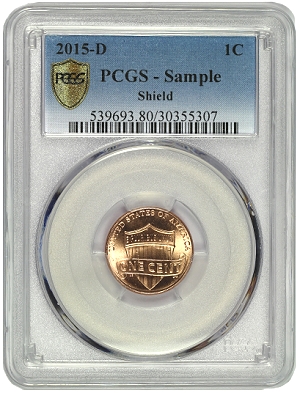 When coin certification began in the 1980s, grading services gave huge numbers of free samples to collectors and dealers to introduce the concept. Often but not always labeled “sample”, these holders continue to serve as marketing giveaways, demonstrations of new designs, or gifts for Set Registry members.
When coin certification began in the 1980s, grading services gave huge numbers of free samples to collectors and dealers to introduce the concept. Often but not always labeled “sample”, these holders continue to serve as marketing giveaways, demonstrations of new designs, or gifts for Set Registry members.
Avidly collected by a numismatic fringe, some sample slabs earn $100 to $500 or more.
The most common samples are NGC 50 State quarters (about $6), NGC or PCGS silver Roosevelt dimes ($15, although more valuable varieties exist), or PCGS Shield cents ($5). Although the values of most samples are modest, they are still well above the value of the enclosed coin and worth picking up. You also might be fortunate enough to find a scarcer and more valuable variety.
-
Accugrade
In 1984, Accugrade became the first company to seal graded coins in hard plastic holders, two years before the debut of PCGS. Early Accugrade holders are “photoslabs”, meaning each contains both a coin and a black-and-white photo of the coin.

Slab collectors value these early examples at about $30 over the value of the enclosed coin. Later Accugrade holders, which do not have photos, earn a premium of around $15.
-
ANACS Blue Text
 ANACS originally stood for “American Numismatic Association Certification Service”. Some people feel that this grader held higher standards when it was still part of the American Numismatic Association (ANA), before its sale to Amos Press in 1990.
ANACS originally stood for “American Numismatic Association Certification Service”. Some people feel that this grader held higher standards when it was still part of the American Numismatic Association (ANA), before its sale to Amos Press in 1990.
ANACS used small white holders from 1988 through 2003, but only the pre-1990 labels have blue text in the background reading “OFFICIAL ANA GRADE”.
There is no specific dollar premium on ANACS blue text holders. Much like PCGS rattlers, check these slabs for premium-quality coins to keep as they are or to re-submit in hopes of a higher grade.
-
PCGS 2.1 and 2.2
 PCGS gave a gift to its fans when it published the Museum of Coin Holders in 2016. This valuable resource tells what slabs exist, the scarcity of each, and how to identify each type.
PCGS gave a gift to its fans when it published the Museum of Coin Holders in 2016. This valuable resource tells what slabs exist, the scarcity of each, and how to identify each type.
At first glance, a 2.1 or 2.2 looks like one of the common green label PCGS holders. However, the transitional 2.1 or 2.2 is a rattler holder surrounded by a clear plastic ring (sometimes called a collar). Both have solid green labels, but the 2.1 has a perforated label while the 2.2 label does not. PCGS used these styles briefly, issuing the 2.1 from October through December 1989 and the 2.2 from December 1989 through January 1990. The ring tends to chip and crack if not handled carefully, and dirt can build up under the ring. These factors make intact, clean holders prized by slab collectors today.
Distinguish a 2.1 / 2.2 from the more common types of green label holder by:
- “PCGS” molded into the ring at the lower right.
- Usually no “PCGS” on the front of the label.
- Four clear plastic locator pins in a square surrounding the coin. These appear in photos as small, faint circles.
A 2.1 / 2.2 earns a premium of $25 – $40 over the value of the enclosed coin, so they are worth picking up, especially if they contain inexpensive coins.
-
Compugrade
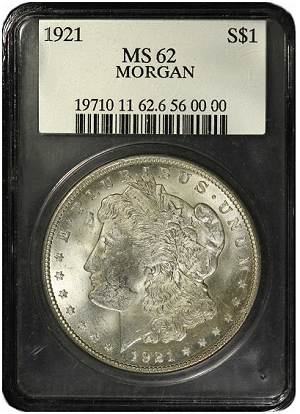 Opened in New Orleans in 1991, Compugrade intended to grade coins using computerized equipment instead of skilled graders. Although they graded coins for a few months, the company closed in the same year. They made one of the most attractive holders of any grading service. The plastic has a clear crystalline quality.
Opened in New Orleans in 1991, Compugrade intended to grade coins using computerized equipment instead of skilled graders. Although they graded coins for a few months, the company closed in the same year. They made one of the most attractive holders of any grading service. The plastic has a clear crystalline quality.
Most holders from services other than the top four of ANACS, ICG, NGC, and PCGS have minimal value to slab enthusiasts. Like Accugrade, Compugrade is one of the few exceptions, and a slab collector will pay about $40 over the value of the enclosed coin.
If you are lucky enough to find a Compugrade labeled “sample”, you have a scarce sample slab worth $250.
-
PCGS Doily
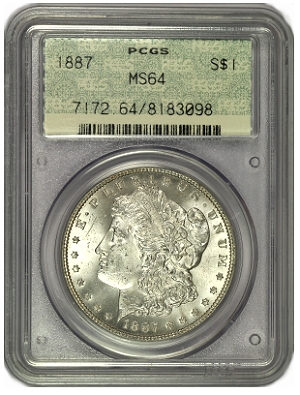 When the first counterfeit PCGS slabs appeared in 1989, PCGS quickly changed their design to protect their brand. The new label had a fine pattern that a computer printer hopefully could not replicate. Later called the “doily” because of the round lacy designs, PCGS made this style only September and October 1989 before replacing it with the 2.1 / 2.2 holder described in #7 above.
When the first counterfeit PCGS slabs appeared in 1989, PCGS quickly changed their design to protect their brand. The new label had a fine pattern that a computer printer hopefully could not replicate. Later called the “doily” because of the round lacy designs, PCGS made this style only September and October 1989 before replacing it with the 2.1 / 2.2 holder described in #7 above.
With its easy-to-recognize label and colorful name, the doily is one of the most popular collectible slabs; major auction houses point out doilies when they receive them on consignment. Even with a common low-value Morgan dollar or Mercury dime, a doily earns at least $150. Less common types, especially world coins, earn more.
Make sure, however, that yours is an original with a white stripe at the bottom of the label. Later “retro” doily labels offered by PCGS do not have this white band.
-
NGC White Label
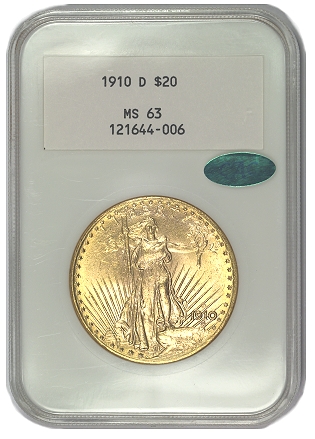 See #1 below for the very first NGC holder, but the second slab from this company has a white insert and an all-white label (the insert is the soft rubber piece that surrounds the coin inside the hard plastic holder.
See #1 below for the very first NGC holder, but the second slab from this company has a white insert and an all-white label (the insert is the soft rubber piece that surrounds the coin inside the hard plastic holder.
With the insert and label the same color, the two blended together, and NGC soon added a brown border to make the white label stand out.
Although some collectors hope to find an undergraded coin in an older holder, the real attraction here is the scarce design. An all-white NGC label earns a premium of $200 or more over the value of the enclosed coin.
-
PCGS White Label
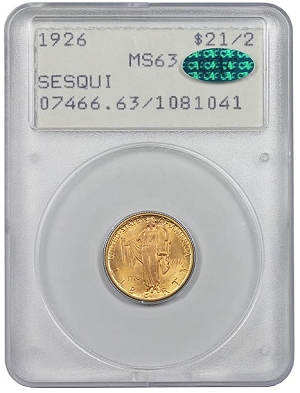 The PCGS Museum of Coin Holders explains that the type 1.0 was used by PCGS only for their first few days in business in February 1986. You can tell the 1.0 by the serial number beginning with 1080, the smooth (not ribbed) label, and dot matrix printing with lower quality than the dot matrix used later.
The PCGS Museum of Coin Holders explains that the type 1.0 was used by PCGS only for their first few days in business in February 1986. You can tell the 1.0 by the serial number beginning with 1080, the smooth (not ribbed) label, and dot matrix printing with lower quality than the dot matrix used later.
GreatCollections sold a PCGS type 1.0 holder for $1,181.25 on November 12, 2017. This is $956 more than the PCGS Price Guide value of the enclosed coin, an MS65 1943-S half dollar. The collector who bought this coin explained that other slab collectors are building type sets, collecting as many different types of coins in 1.0 holders as possible. A Morgan, he continued, is more common (although all 1.0 holders are rare) and would earn a smaller premium.
A type 1.1, similar but with better dot matrix printing, is nearly as scarce. Because the green labels on some common type 1.2 holders (the familiar rattler) have faded to white, check the surface of the label before deciding that you have a 1.0 or 1.1. The common 1.2 label is ribbed with horizontal lines, while the 1.0 and 1.1 labels are smooth.
-
PCGS Regency
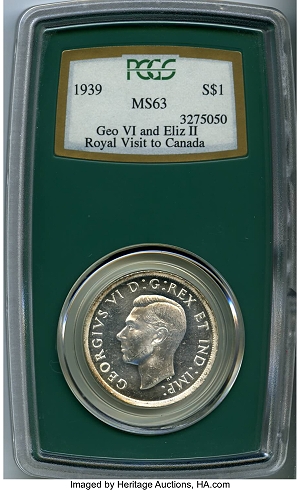 If you want a slab that will impress any collector, find a Regency. It won’t be easy to find, as PCGS made only about 700 of these oversized green holders between 1992 and 1996. Try to get the green velour drawstring bag in which it originally came.
If you want a slab that will impress any collector, find a Regency. It won’t be easy to find, as PCGS made only about 700 of these oversized green holders between 1992 and 1996. Try to get the green velour drawstring bag in which it originally came.
Because most Regency slabs held valuable coins (I saw a million-dollar coin in one at the 2017 Denver ANA convention), they are hard to value. About half of all Regencies have 1958 Israel 5 lirot coins pedigreed to the estate of comedian Danny Kaye and sold with a custom box and other extras. Expect to pay $500 for a Danny Kaye Regency by itself or $800+ for a full “box and papers” set. These values may be increasing. Heritage Auctions recently sold a Regency with another low-value coin (a 1939 Canada dollar in MS63 worth about $40) for $1,440 including the buyer’s premium.
-
NGC Black
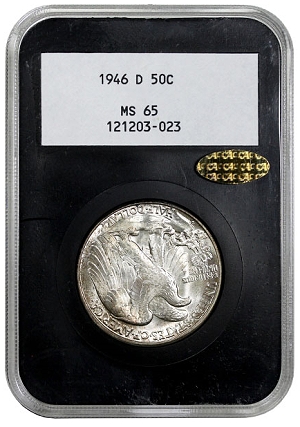 It’s not as wild as the Regency or doily, but the piece most coveted by slab collectors is the NGC black. The first NGC production slab, this one has no hologram, and a black insert instead of the familiar white insert surrounding the coin. Lustrous coins such as gold or white silver popped against the black, but brown copper or circulated silver coins faded into the background. NGC quickly switched to the white insert they still use today.
It’s not as wild as the Regency or doily, but the piece most coveted by slab collectors is the NGC black. The first NGC production slab, this one has no hologram, and a black insert instead of the familiar white insert surrounding the coin. Lustrous coins such as gold or white silver popped against the black, but brown copper or circulated silver coins faded into the background. NGC quickly switched to the white insert they still use today.
Estimates of the number of remaining NGC blacks range from 25 to 200, but it is clear that they rarely appear for sale and bring strong prices. (This does not include “retro” black holders made by NGC starting in 2013). As an example, in 2016 GreatCollections sold one with an MS65 1946-D half dollar ($50 in the NGC price guide) for $3,740 including buyer’s premium.
Collecting coin holders instead of coins might sound like a strange pursuit, but it is no different than collecting other offshoots such as auction catalogs, coin albums, or numismatic books. Based on the values seen above, more people are coming to the same conclusion and adding some choice plastic to their collections.
NGC-Certified Original GSA Holder Morgan Silver Dollars Currently Available on eBay
[wpebayads]





I recently purchased a 1921 “Pilgrim” coin slabbed in an old Silvertowne Numismatic Portfolios, Inc. slab. They were doing grading from ’86-’88 from what I’ve been able to find and they dissolved the operation in ’90. I can’t find much on them other than a couple chat boards. It’s an awesome holder a bit larger than a GSA dollar holder. It looks like a type of Capital holder but w/ brass rivets instead of plastic screws. I’ve heard these can go for a premium as well.
The coin is graded as MS 62 and is under graded in my opinion as it’s nearly flawless-almost no surface marks at all and excellent luster with a slight toning. They missed a struck through error on the rev. and it has a couple nice die cracks in it too. When I bought it, I was thinking “crack it out and send it to NGC to try for a better grade”, but after getting it in hand, I think it would be doing a disservice to the coin, the holder and the Silvertowne name.
All told it’s a very neat find & being the Christmas holiday period, I had to get myself this present. And being the ’21 Pilgrim, I got it on the cheap too-just one of those things you stumble into I guess!
What is the company “World High Standard Grading”..can’t find it anywhere on the internet. Bought a Morgan dollar..looks really good. But curious???
Thanks,
Robert
The two grading services that we recommend you look into for industry-acceptable third-party coin grading are Numismatic Guaranty Corporation and Professional Coin Grading Service.
Some fly by night wahoos .
I have a 1908 $20 Double Eagle MS63 in the black retro holder w/ gold label. Is this desirable?
Clarify: it is not retro. It is original black. Well before 2013.